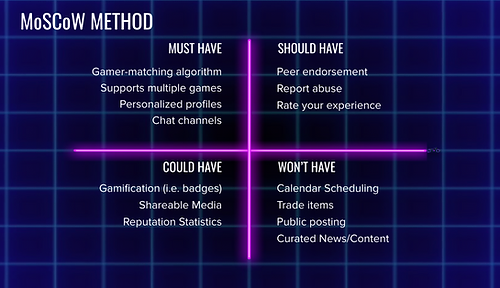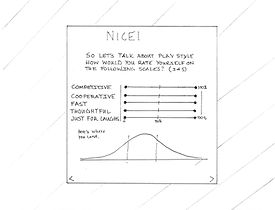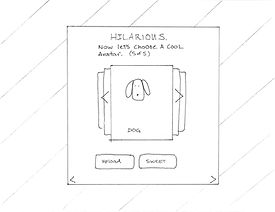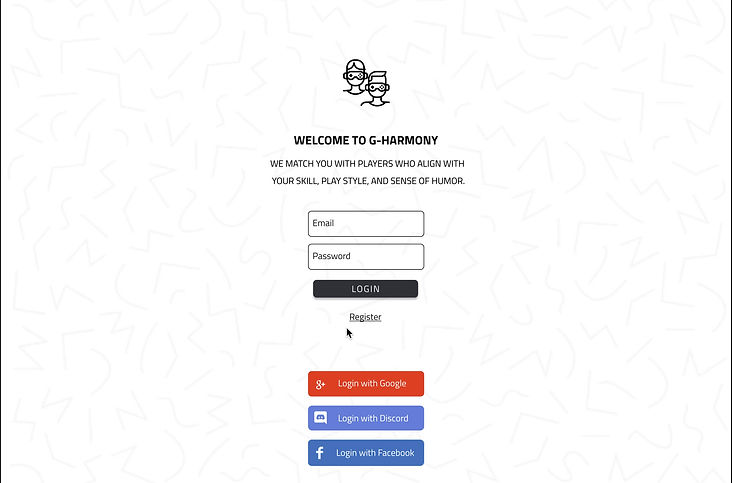G-HARMONY
An app for matching gamers together like a dating site.

Methods
Topic Map
Screener Survey
User Interviews
Affinity Map
Persona Development
Competitive Analysis
MoSCoW Map
Feature Prioritization
Design Studio
Rapid Prototyping
Usability Tests
User Report
Tools
Figma
Google Slides
White Board
Pen & Paper
Team
Katie Luo
Richard Lam
Dave Coughlin
My Roles
UX Designer
UX Researcher
PROBLEM SPACE
When my design team began looking for an issue to solve in the gaming industry and we were immediately confronted by the problem of toxic culture.
But changing people’s behavior is, to be frank, nearly impossible. And what exactly defines toxicity? I think we all know toxicity when we see it, but when does a clever jibe become too much? There is an inherent subjectivity to what is socially appropriate, and that compounds the difficulty in addressing the issue of toxic behavior in online banter.
RESEARCH & SYNTHESIS

Topic Map
As a team we needed to choose a place to start. What were we going to make? Who were we going to help and why?

Screener Survey
We needed to narrow our interviewees down to getting a better understanding of our primary user, without any statistical noise.

User Interviews
Our user interviews served as the foundation of our research, and gave us invaluable insight moving forward.

Affinity Map
The process of affinity mapping funneled our user interviews into key insights.


Persona Development
Competitive Analysis
Our persona was a synthesis of our user interviews and key insights, and served as our compass throughout the design process.
We looked at competitors and comparators to see if and how other companies were tackling the problem.

USER INTERVIEWS: FINDING A PROBLEM
We began with 5 user interviews of individuals who had played games online within the last month. We asked them a range of questions pertaining to what they enjoyed about gaming, how they found people to play with, what problems did they face as a gamer IRL, what were their goals in the games they played.
We were unable to find a problem that we felt we are able to tackle after 5 interviews, so we conducted another 3 interviews. After 8 interviews we finally realized that the majority of gamers had at some point struggled to find people to play a game with.
INTERVIEW INSIGHTS
8/8 users acknowledge the culture of toxicity is a problem, but not everyone was affected equally. Women and non-binary people were most affected.
Games currently have player matching algorithms, but they are based on skill alone and don't account for congruent strategies, in-game goals, and personalities.
7/8 users had at some point struggled to find another person they enjoyed playing with.
Users don't want to fill out lengthy forms. They want to get playing as fast as possible.

PROBLEM STATEMENT
Online gamers have specific standards and criteria for who they want to play with.
Derek has been gaming for five years, and he still struggles to find people who match his play style, are at his skill level, and share a similar sense of humor with him.
How might we help Derek find other players he can have a good experience with and subsequently form a lasting connection with?
COMPETITIVE ANALYSIS
Competitive Landscape Matrix
We looked at several companies that were offering a similar service.
What we found was that there was a wide open area of the market.
Other companies offering the same service are either made for a specific game, or require a larger initial investment before you get matched with another gamer.

Feature Analysis

A feature analysis of our competitors and comparators gave us an idea of what we needed to include in our product as well as areas where we could differentiate ourselves. One large observation we noted was that
none of the competitors had a "rate your experience" feature.
Thus no current gamer matching algorithm on the market could get better over time.
IDEATION & IMPLEMENTATION
Moscow Map
To clarify what features were critical to user success, we quickly created a MoSCoW Map.
Design Studio
We needed to know what features would be feasible to create for our MVP before we started designing.
Feature Priority Map
We needed to know what features would be feasible to create for our MVP before we started designing.
Rapid Prototyping
To clarify what features were critical to user success, we quickly created a MoSCoW Map.
MOSCOW MATRIX

In order to make a minimum viable product we needed to have clarity on what features were necessary and which could be left out. The Moscow Matrix prevents our developers from getting bogged down with technical debt, our users from being overwhelmed, and helps our product get to market faster.
FEATURE FEASIBILITY
We wanted to ensure that our essential features were actually viable, so we talked to our friends in the software engineering field. Fortunately for us,
the features that were essential and the easiest to produce were the same features that were critical to our MVP —
with the exception of the "report abuse" feature.

PAPER WIREFRAMES
We did a design studio for every screen in the user's path. While this was time consuming it also gave us a great insight into the eyes of a user. The images here show a part of the on boarding process for G-Harmony.






We created a low fidelity wireframe (a paper prototype) as a quick way to get feedback from users. We ran 3 users tests to make sure we were on the right track before developing our design further.
USABILITY TESTS
1/5 users were able to use the sliders to input their gaming attributes.
So we scrapped that immediately.
4/5 users wanted more specific language regarding the game they were interested in,
and less general personality questions.

HIGH-FIDELITY PROTOTYPE


NEXT STEPS
-
Expand the mobile experience for users on the go
-
Incorporate additional demographic questions
-
Further research into providing healthy, effective gaming spaces for youths, female-identifying and non-binary gamers
-
Matching feature for a full team of players
-
Build additional pages for a returning user
-
Home page or dashboard page
-
Messaging window with conversations between many gamers
-